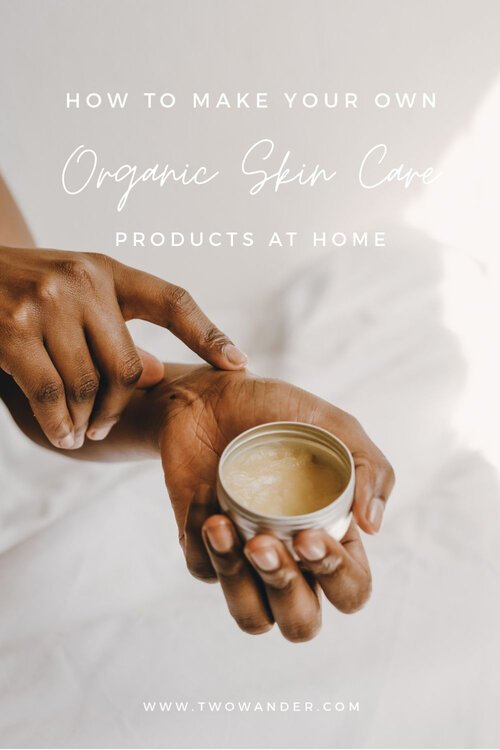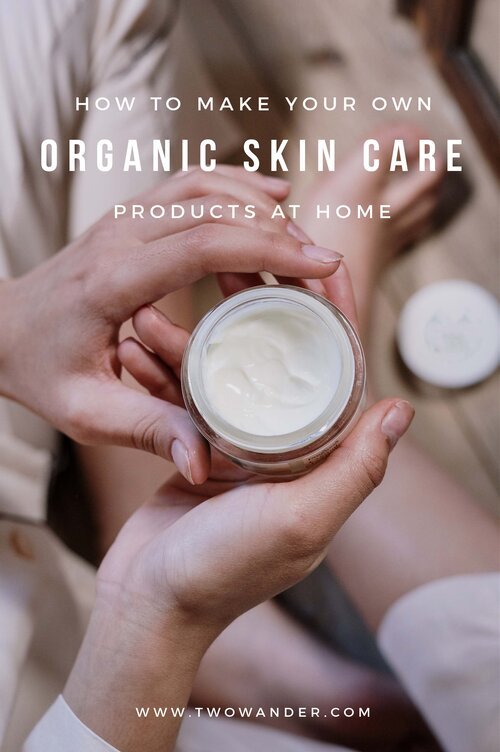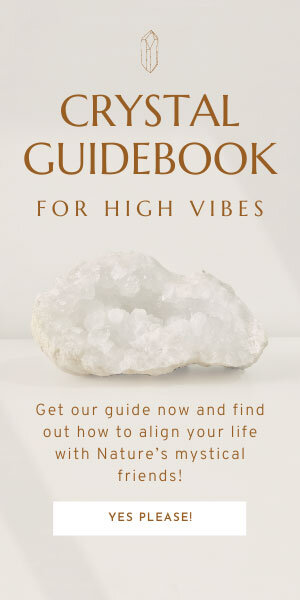How To Make Organic Skin Care Products At Home
Please note this post may contain affiliate links. If you choose to purchase through these links, we may receive a small commission at no extra cost to you. By using these links you are directly supporting Two Wander to continue providing you with free content to stoke your curiosity for conscious wandering + holistic well-being. Thank you!
How To Make Organic Skin Care Products At Home
I absolutely LOVE making my own skin care products, it’s so easy, cheaper than store-bought, custom-tailored to my own needs and, more importantly, natural and organic- as well as super concentrated! There’s no pointless fillers when you’re making your own cosmetics, part of the reason why I started is because I was so disappointed in continuously seeing the first ingredient on most face creams, including expensive reputable brands, to be aqua, i.e. water!
The second, and biggest, reason why I started was because, of course, I was sick of even the “natural” brands containing mineral oil, parabens or other questionable ingredients. Finally, I wanted something that truly catered to what my skin actually needed and I could pick and choose top-performing, quality ingredients for and customize them based on my current needs too, such as if it is hot and humid or dry and cold outside. As I was researching what are the best ingredients for skin I found there are a few science-backed heavy-hitters and the rest are mostly marketing buzz.
This is coming from someone in her 30s with normal-oily skin that is totally unproblematic, but it didn’t start that way! Another reason why I began my holistic skin care journey was because I had just come off the pill and had TERRIBLE breakouts. Now, 5 years on, I don’t remember the last time I had a spot and my skin is equally as glowy in summer as it is in winter. The products I make are generally more suited to those who prefer a dewy look and/or suffer from dry or sensitive skin. But they are equally as good for combination, normal and oily skin (like me) too. The full regimen will also help with acne (again like me) and ageing skin as well.
In this post I’ll discuss additional recipes to complement those in my first post that covered the basics of homemade skincare: Gentle Face Wash, Soothing Toner, Hydrating Face Cream, and Nourishing Face Oil. Here, I’ll show you how to make the rest of my clean beauty arsenal, which are:
A Purifying Face Mask
Healing Spot Cream
Balancing Deodorant (cream and spray)
Comforting Perfume (roll-on and spray)
Softening Hair + Scalp Mask
I would say these are the main products to give a go, I actually have recipes for about 30 different products in total (extending to cleaning spray etc.) but that’s a post for another day! For now, read on below to find out how you too can make these easy, homemade organic products.
Purifying Face Mask
This is a great skincare product to add to your existing regime because of its customisability it’s a one-size-fits-all mask. I like to do this facial routine on my self-care Sundays: after cleansing with my gentle face wash and exfoliating with some coffee grinds (caffeine is great for energising the skin, helping with pigmentation and under-eye dark circles, as well as pimples), I then apply this mask for 20 minutes. If you have dry/sensitive skin, you could try applying it for less and spraying a face mist on top (clay draws out moisture from the skin which is balancing and purifying, but can also be too drying for some), as well as making adjustments to the list below:
Recipe
1 tbsp DIY Gentle Face Wash (or just plain honey)
1 tbsp Clay (I buy bentonite clay in bulk now and it lasts YEARS but diatomaceous earth works well too)
1 tbsp Kefir (or milk/yoghurt - the lactic acid present is a great skin brightener and exfoliator. If you’re vegan, you can try a substitute)
1 tsp Aloe Vera (optional)
Mix all the ingredients together, apply to clean skin, avoiding the eye area and voila! Baby-soft skin. I always like to add a bit of moisturiser to my eye area so that they’re not just drying out while I’m waiting for the mask to do its thing. For dry skin, you can add less clay, skip it altogether, or add in extra honey/aloe vera. Rinse off and follow with your regular serums/eye creams, if any, and moisturiser. One of my favourite skin care tips is to use a gua sha or jade roller as a final step- you’ll have cheekbones like never before! It’s also really good for helping with puffy eyes, especially if you keep yours in the fridge. I do a lymph drainage massage with mine every night.
Healing Spot Cream
This cream is SO good, whenever I used to get a spot it would be gone the next day with this healing gel on overnight. It’s deceptively simple but don’t let that fool you! Bonus points: it can also double up as an after-sun if you make enough (you could also add some witch hazel and oils for extra repairing action).
Recipe
1 tbsp Aloe Vera
1 drop Lavender Essential Oil
1 drop Tea Tree Essential Oil
Mix together and that’s it! I make a really small tub of it but you can make more and adjust to your needs. You may have already heard about how great tea tree oil is for dealing with spots, and it can be used alone but I like to add in the extra-healing aloe vera and lavender for extra effect. Simply apply a couple of times throughout the day with clean hands and you’re all set. Because this can be pretty powerful stuff, if you have sensitive skin, you might like to increase the amount of aloe vera and just apply it once a day. As with each formula, test one out to see how you like it and adjust accordingly!
Balancing Deodorant
I was initially SUPER skeptical about switching to a natural deodorant because I’d been a hardcore lover of my favourite brand for years and was scared about what the change would be like- would I just sweat through all my clothes?! I’m very happy to report however that no, you won’t sweat through all your clothes, and you’ll smell as fresh as a daisy all day too!
I really love my natural deodorant but it does take a little bit of adjusting to in the beginning. You might have heard about the need for getting rid of potentially cancer-causing aluminium deodorants and that your armpits may detox after the switch. While I don’t think my pits went through a detox, it did take some getting used to not being 100% sandpaper dry in extreme heat because this is not a classic antiperspirant (although it does help to a certain extent of course).
I first realised I could live a more natural, in tune life with my pits when we were travelling around parts of South America. Living in vest tops and hot weather, I stopped wearing deodorant because I didn’t need it- the first thing we did every day was go straight for a swim, and then the sea salt was enough after! I guess my armpits did detox because they actually started sweating less altogether and I think this is part of the allure of switching to a natural formulation for me: training your glands to resort back to a natural balance (I imagine it’s much like how we now know that washing your hair every day isn’t good for your strands and can actually cause more oil production).
While I don’t know for sure if this is what happened, I do know that the reason I was such a diehard fan of one type of deodorant before was because literally NOTHING else worked for me. Now, I couldn’t imagine not making my own!
Recipe
5 tbsp Coconut Oil
3 tbsp Cornstarch
1 tbsp Baking Soda
1 tbsp Clay
1 tbsp Lemon
1 tbsp Apple Cider Vinegar
Pinch of Salt
10 drops of essential oil (I go for tea tree and peppermint oil for their antibacterial properties and scent)
For the method, I recommend first mixing all the dry ingredients together (except the salt), then adding in the coconut oil and essential oils. Mix together well to form a paste. In a separate bowl, add the lemon and apple cider vinegar and dissolve the salt in it. Then, add this to the paste and mix continuously and vigorously until well amalgamated. The acids will react with the alkaline baking soda to fizz and evaporate a bit- if you keep mixing well as this is happening, you should end up with a firm paste that is easy to scoop into a container and then under your arms.
If you don’t have all of the dry ingredients, you can mix and match them as long as they are always in equal parts with the amount of coconut oil you use. If you have sensitive skin you can omit the baking soda and/or lemon and apple cider vinegar. For a bonus recipe, you can try and add all these ingredients to some witch hazel, alcohol and water for a spray solution! I personally make both.
The consistency of the cream is quite thick but it does have to be applied with your finger. If you prefer it to be more solid, such as a traditional stick, you can melt the coconut oil mixture with 2 tsp beeswax before the acids and pour it into an empty roll-on container.
Comforting Perfume
I call this a comforting perfume because I don’t quite know how else to all call the scent haha all I know is that it smells YUMMY and I love it. The great thing about making your own perfume (apart from ridding yourself of all the toxic, cancer-causing, endocrine-disrupting fragrances of course), is that you get to wholly pick and choose exactly what kind of scent you like! A word of warning though, sadly this is not like typical perfumes because the scent won’t last as long.
This means that if you want the smell to linger around longer, you’ll have to apply it more frequently. Personally, I don’t mind this. I give myself a spritz and a roll-on every morning and then a refresher at lunchtime as a little pick-me-up and I really enjoy it that way.
Recipe
Water or Rosewater for the spray (with optional alcohol/vodka). Coconut oil for the roll-on
30-50 drops of your favourite essential oils!
The mix I like to go for is 10 drops of lavender, 10 of rose, 5 of ylang ylang, 5 of jasmine, 5 of orange, and 5 of peppermint. This gives a really nice deep floral, vanillary aroma that is also refreshing and uplifting, and a bit earthy. Altogether I find this quite comforting, hence the name. The alcohol/vodka is said to help the scent last longer. I use the spray more as a body spray than a perfume and spritz it all over once I’m dressed, then add the roll-on to my pulse points which is also great for little moments of mindfulness throughout the day.
Softening Hair + Scalp Mask
OK this is no joke an absolute MIRACLE worker- if there’s one thing you try from this list I strongly suggest it to be this! I’ve only been making this mask for about 8 months now (using it roughly once a month) and still every time I do it I’m completely blown away by just how goddamn shiny and soft my hair becomes!
However, to get the end results, you do have to pass a bit of an icky phase, no pain no gain right? This is an egg-based mask so the application process is not exactly pleasant, but seriously the results are so so worth it (I’m used to it now anyway and really look forward to it just for the outcome). I would also suggest using a clarifying shampoo after to really make sure any residue, and other buildup, is gone.
Recipe
1 egg
2 tbsp hair oil (I make it with a 1:1 ratio of coconut and olive oil as these are good at penetrating the hair shaft and deeply nourishing the strands respectively. Then I add a couple of drops of clary sage and rosemary essential oil as these are said to be anti-aging and stimulating for the hair follicles but these are optional. This is a really good oil for using before swimming too)!
Mix together and that’s it! I have tried to add in extra honey and coconut milk to the recipe too but I didn’t like the effect as much because although it did leave my hair extremely soft, I found it to be shinier when I used just the hair oil and egg. For the application, I recommend doing it naked, or in something you don’t mind dirtying, over a sink. Start with your ends and slowly work your way up to your scalp. You can pour any remaining mix directly on top of your scalp but be careful because it’s quite runny!
After you’ve massaged it in well, you’ll have to tie your hair up quite quickly (if you want to) because it hardens when it dries! You may be thinking as you have it in place “how the hell is this going to make my hair soft?” but have faith! As soon as you rinse if out your strands will be baby soft. After double cleansing with a good shampoo, applying your conditioner and leave-in conditioner, and you’ll be amazed at how glossy your hair is once it dries!
So that’s how to make organic DIY skin care products at home. When you’re first buying your ingredients, you may have to make an initial bulk purchase but they will last you SO long. Plus, not only is it a great way to get concentrated, tailored products- it’s really fun too! Whilst you’re making the switch to a holistic regimen, you may as well opt for organic too so you’re free from pesticides etc as well.
If you try any recipes out I’d absolutely LOVE to know how you get on in the comments section below! Or, if you have any questions please don’t hesitate to let me know- I’m more than happy to help. If you already make your own products- what else do you make or do differently? Share your tips and I’ll try them out :)
Don’t forget to check out my original post on How To Make Your Own Clean Beauty Products for the natural face wash, toner, moisturiser and face oil if you’re interested too.






















